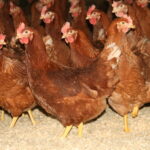by Madalina Diaconu, Global Manager Gut Health, EW Nutrition
Coccidiosis, caused by Eimeria spp., is a major challenge in poultry production, leading to significant economic losses. Historically, control strategies have relied on chemical anticoccidials and ionophores. However, the emergence of drug-resistant Eimeria strains and consumer concerns about chemical residues necessitate alternative solutions. Phytogenics, especially tannins and saponins, offer promising natural solutions to be included in programs for coccidiosis control. More and more independent research highlights the potential of these natural compounds to enhance poultry health and productivity.
Efficacy of Tannins and Saponins in Coccidiosis Control
Phytogenics are plant-derived bioactive compounds known for their antimicrobial, antioxidant, and immunomodulatory properties. Among these, tannins and saponins have shown particular promise in supporting coccidiosis control.


The challenge: Preventing the spread of infections and mitigating subclinicial coccidiosis before it reaches this stage.
Tannins
Tannins are polyphenolic compounds found in various plants. They exhibit strong antimicrobial activity by binding to proteins and metal ions, disrupting microbial cell membranes, and inhibiting enzymatic activity.
Anticoccidial Activity: Tannins have been shown to interfere with the life cycle of Eimeria. Studies demonstrate that tannins can reduce oocyst shedding and intestinal lesion scores in infected birds (Abbas et al., 2017).
Immune Modulation: Tannins enhance immune responses by promoting the proliferation of lymphocytes and the production of antibodies, which help in the clearance of Eimeria infections (Redondo et al., 2021).
Saponins
Saponins are glycosides with surfactant properties, capable of lysing cell membranes of pathogens. They also stimulate immune responses, enhancing the host’s ability to fight infections.
Membrane Disruption: Saponins disrupt the cell membranes of Eimeria, leading to reduced parasite viability and replication (Githiori et al., 2004).
Immune Enhancement: Saponins stimulate the production of cytokines and enhance the activity of macrophages, improving the overall immune response against coccidiosis (Zhai et al., 2014).
Independent Research Evidences Phytogenics’s Role in Supporting Programs for Coccidiosis Control
Numerous studies have evaluated the efficacy of phytogenics in coccidiosis control. Here, we highlight key findings from peer-reviewed research:
Abbas et al. (2012): This study reviewed various botanicals and their effects on Eimeria species in poultry. The authors concluded that tannins and saponins significantly reduce oocyst shedding and lesion scores, comparable to conventional anticoccidials.
Allen et al. (1997): The authors investigated the use of dietary saponins in controlling Eimeria acervulina infections. The study found that saponin-treated birds exhibited lower oocyst counts and improved weight gain compared to untreated controls.
Masood et al. (2013): This study explored the role of natural antioxidants, including tannins, in controlling coccidiosis. The results indicated that tannins reduced oxidative stress and improved intestinal health, leading to better performance in broiler chickens.
Idris et al. (2017): The researchers assessed the potential of saponin-rich plant extracts against avian coccidiosis. The findings demonstrated significant reductions in oocyst output and lesion severity, highlighting the potential of saponins as effective anticoccidials.
Hailat et al. (2023): The researchers studied three phytogenic formulations against a control group with chemical drugs. The study concluded that phytogenic blends can be safely used as alternatives to the chemically synthesized drugs, either alone or in a shuttle program, for the control of poultry coccidiosis.
El-Shall et al. (2021): This review article highlights research findings on phytogenic compounds which showed preventive, therapeutic, or immuno-modulating effects against coccidiosis.
Despite initial skepticism, the growing body of evidence supports the efficacy of phytogenics in supporting coccidiosis control. Tannins and saponins, in particular, have shown significant potential in reducing parasite load, improving intestinal health, and enhancing immune responses. These natural compounds offer several advantages over traditional chemical treatments, including lower risk of resistance development and absence of harmful residues in meat products.
Challenges and Promises
While the efficacy of phytogenics is well-supported, challenges remain, especially with lower-quality products that may display variability in plant extract composition, in their standardization of doses, and in ensuring consistent quality. At the same time, these compounds are not silver bullets, and no producer should make unreasonable claims.
As far as the mode of action is concerned, the evidence is becoming clear: phytogenics, particularly tannins and saponins, are effective in mitigating gut health challenges and supporting bird performance when challenged. Their natural origin, coupled with potent antimicrobial and immunomodulatory properties, makes them suitable for sustainable poultry production. As the poultry industry seeks to reduce reliance on chemical drugs, phytogenics represent a viable and promising solution.
References
Abbas, R. Z., Iqbal, Z., Blake, D., Khan, M. N., & Saleemi, M. K. (2011). “Anticoccidial drug resistance in fowl coccidia: the state of play revisited”. World’s Poultry Science Journal, 67(2), 337-350. https://doi.org/10.1017/S004393391100033X
Allen, P. C., Danforth, H. D., & Levander, O. A. (1997). “Interaction of dietary flaxseed with coccidia infections in chickens”. Poultry Science, 76(6), 822-828. https://doi.org/10.1093/ps/76.6.822
El-Shall, N.A., El-Hack, M.E.A., et al. (2022). “Phytochemical control of poultry coccidiosis: a review”. Poultry Science, 101(1) 101542. https://doi.org/10.1016/j.psj.2021.101542
Idris, M., Abbas, R. Z., Masood, S., Rehman, T., Farooq, U., Babar, W., Hussain, R., Raza, A., & Riaz, U. (2017). “The potential of antioxidant rich essential oils against avian coccidiosis”. World’s Poultry Science Journal, 73(1), 89-104. https://doi.org/10.1017/S0043933916000787
Hailat, A.M., Abdelqader, A.M., & Gharaibeh, M.H. (2023). “Efficacy of Phyto-Genic Products to Control Field Coccidiosis in Broiler Chickens”. International Journal of Veterinary Science, 13(3), 266-272. https://doi.org/10.47278/journal.ijvs/2023.099
Masood, S., Abbas, R. Z., Iqbal, Z., Mansoor, M. K., Sindhu, Z. U. D., & Zia, M. A. (2013). “Role of natural antioxidants for the control of coccidiosis in poultry”. Pakistan Veterinary Journal, 33(4), 401-407.
Redondo, L. M., Chacana, P. A., Dominguez, J. E., & Miyakawa, M. E. (2021). “Perspectives in the use of tannins as alternative to antimicrobial growth promoter factors in poultry”. Frontiers in Microbiology, 12, 641949. https://doi.org/10.3389/fmicb.2021.641949
Zhai, H., Liu, H., Wang, S., Wu, J., & Kluenter, A. M. (2014). “Potential of essential oils for poultry and pigs”. Animal Nutrition, 2(4), 196-202. https://doi.org/10.1016/j.aninu.2016.12.004















